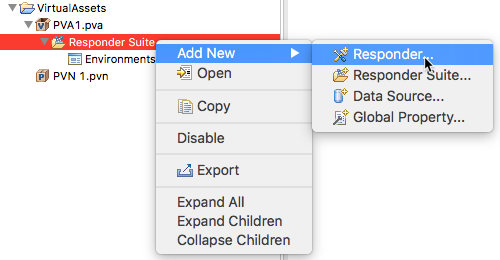If you want to virtualize a service that is not available and is not described by a WSDL or schema, you can virtualize it by manually adding Message Responders that represent the related behavior. In this section:
Adding a Message Responder
A project contains one ore more Parasoft Virtual Asset files (.pva). These files contain one or more Responder Suites, which contain one or more Message Responders. Before you can manually add a Message Responder, you must build out this structure. See Adding Projects, Virtual Assets, and Responder Suites for details.
- Right-click on a Responder Suite and choose Add New> Responder. You can also click the Add Responder or Output button in the toolbar (see Adding Responders, Output Tools, and Validations).
- Choose a type of Message Responder and click Finish. See Virtualization Tools for details about the Message Responders in Virtualize.
- Configure the Message Responder in the tool configuration panel. See Message Responder Overview for details. You can customize the Form Input controls under the Response tab to either SOAP messages or plain XML messages.
Deploying the Virtual Assets
If the .pva is created directly in the VirtualAssets project, it will be deployed automatically. Otherwise, the simplest way to deploy the virtual asset is to copy the containing .pva file into the VirtualAssets project. Alternatively, you could right-click the Virtualize Server view’s Local machine node, choose Add Virtual Asset, specify the .pva file that includes the virtual assets you want to deploy, then click Finish. When the wizard completes, Virtualize will automatically copy the .pva file to the VirtualAssets project. For a more detailed discussion of deployment procedures and options, see Deploying Virtual Assets.
Customizing the Virtual Assets
For details on how to customize the Message Responder’s behavior, see Message Responder Overview.
